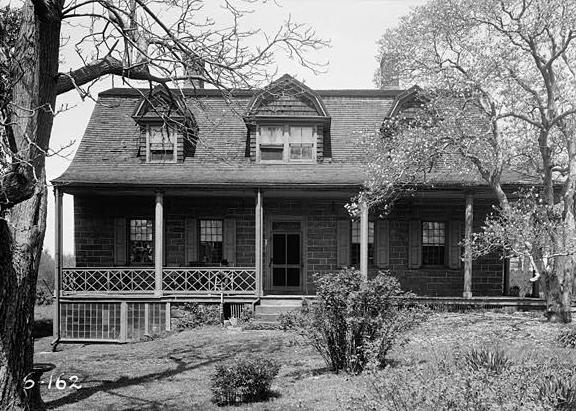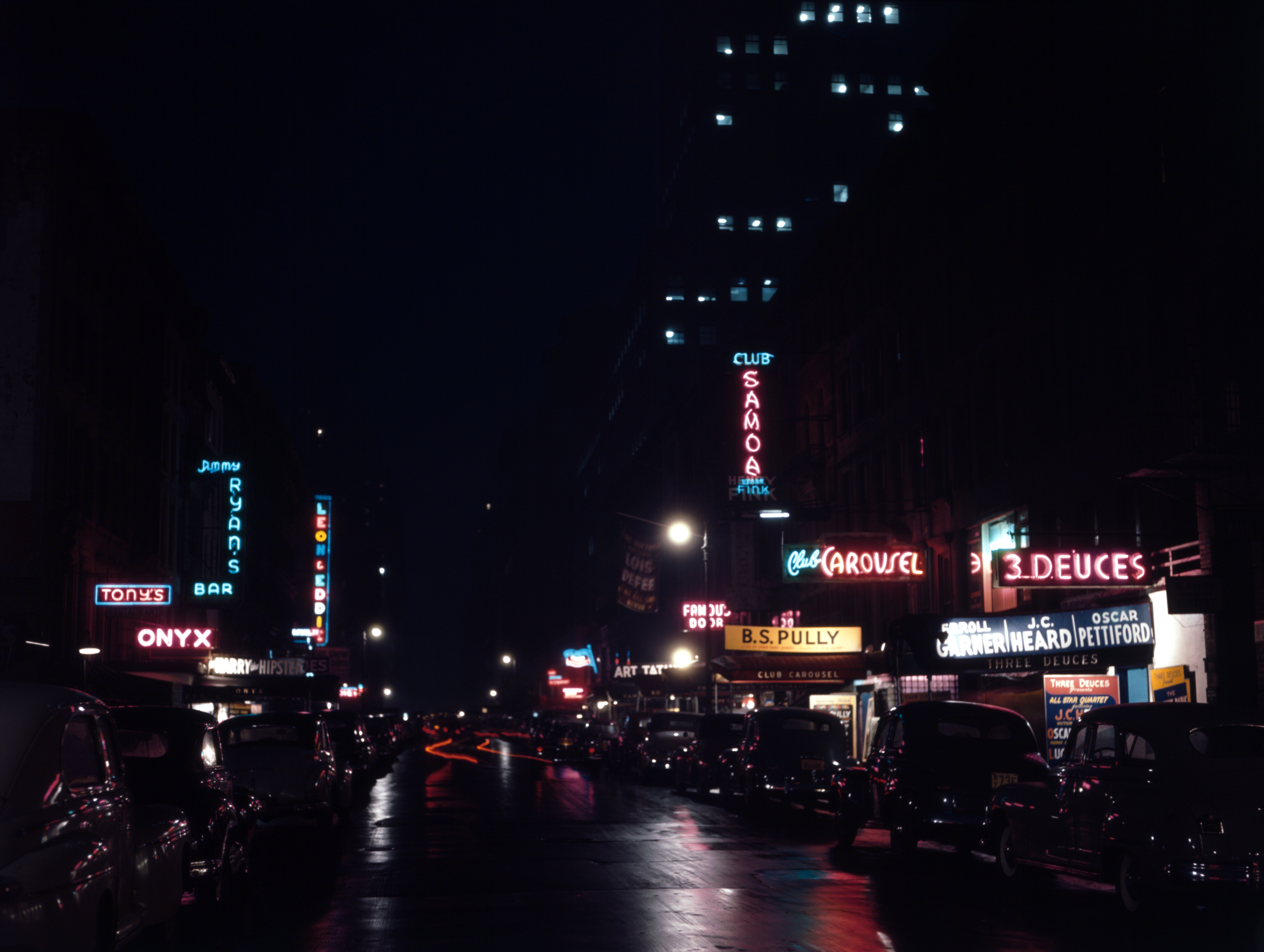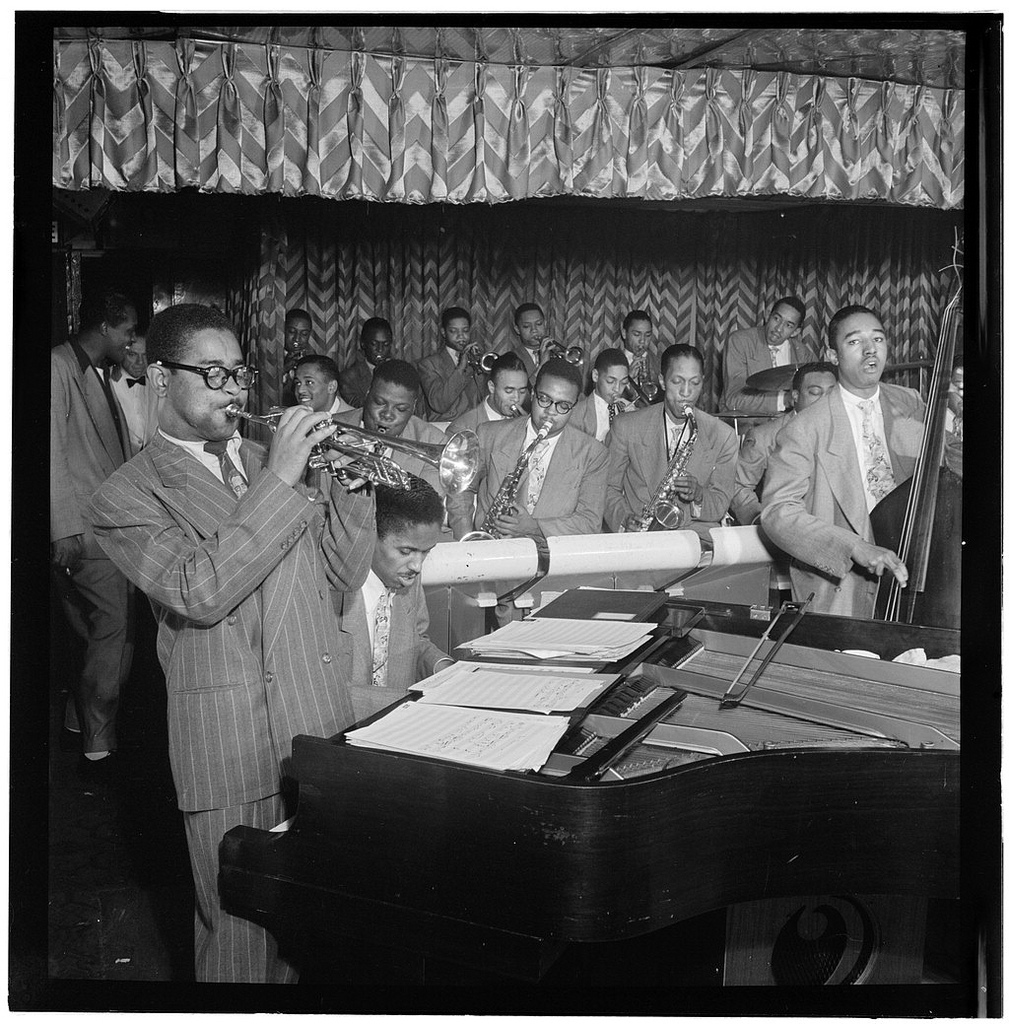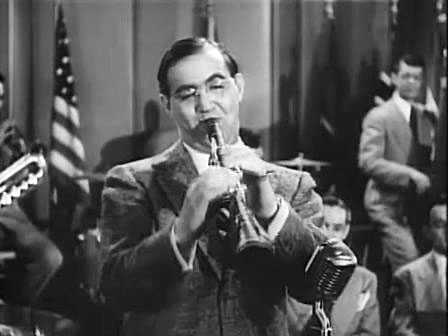|
Slam Stewart
Leroy Eliot "Slam" Stewart (September 21, 1914December 10, 1987) was an American jazz double bass player, whose trademark style was his ability to bow the bass (arco) and simultaneously hum or sing an octave higher. He was a violinist before switching to bass at the age of 20. Biography Stewart was born in Englewood, New Jersey, United States and began playing string bass while attending Dwight Morrow High School. While attending the Boston Conservatory, he heard Ray Perry singing along with his violin. This gave him the inspiration to follow suit with his bass. In 1937, Stewart teamed with Slim Gaillard to form the novelty jazz act Slim and Slam. The duo's biggest hit was "Flat Foot Floogie (with a Floy Floy)" in 1938. Stewart found regular session work throughout the 1940s with Lester Young, Fats Waller, Coleman Hawkins, Erroll Garner, Art Tatum, Johnny Guarnieri, Red Norvo, Don Byas, Benny Goodman, and Beryl Booker. One of the most famous sessions he played on took ... [...More Info...] [...Related Items...] OR: [Wikipedia] [Google] [Baidu] |
Englewood, New Jersey
Englewood is a city in Bergen County, in the U.S. state of New Jersey, which at the 2020 United States census had a population of 29,308. Englewood was incorporated as a city by an act of the New Jersey Legislature on March 17, 1899, from portions of Ridgefield Township and the remaining portions of Englewood Township.Snyder, John P''The Story of New Jersey's Civil Boundaries: 1606-1968'' Bureau of Geology and Topography; Trenton, New Jersey; 1969. p. 77. Accessed February 14, 2012. History Origin of name Englewood Township, the city's predecessor, is believed to have been named in 1859 for the Engle family. The community had been called the " English Neighborhood", as the first primarily English-speaking settlement on the New Jersey side of the Hudson River after New Netherland was annexed by England in 1664, though other sources mention the Engle family and the heavily forested areas of the community as the derivation of the name. Other sources indicate that the name is ... [...More Info...] [...Related Items...] OR: [Wikipedia] [Google] [Baidu] |
Fats Waller
Thomas Wright "Fats" Waller (May 21, 1904 – December 15, 1943) was an American jazz pianist, organist, composer, violinist, singer, and comedic entertainer. His innovations in the Harlem stride style laid much of the basis for modern jazz piano. His best-known compositions, " Ain't Misbehavin'" and " Honeysuckle Rose", were inducted into the Grammy Hall of Fame in 1984 and 1999. Waller copyrighted over 400 songs, many of them co-written with his closest collaborator, Andy Razaf. Razaf described his partner as "the soul of melody... a man who made the piano sing... both big in body and in mind... known for his generosity... a bubbling bundle of joy". It is likely that he composed many more popular songs than he has been credited with: when in financial difficulties he had a habit of selling songs to other writers and performers who claimed them as their own. Waller started playing the piano at the age of six, and became a professional organist at 15. By the age of 18, he was ... [...More Info...] [...Related Items...] OR: [Wikipedia] [Google] [Baidu] |
Dizzy Atmosphere
''Dizzy Atmosphere'' is a jazz standard by Dizzy Gillespie originally recorded in 1945 with Charlie Parker. Harmonically, it is based on the chord progression found in George Gershwin's I Got Rhythm, or "rhythm changes Rhythm changes are a common 32-bar chord progression in jazz, originating as the chord progression for George Gershwin's " I Got Rhythm". The progression is in AABA form, with each A section based on repetitions of the ubiquitous I–vi–ii– ..." as referred to in jazz. References {{1940s-jazz-composition-stub 1945 compositions 1940s jazz standards Compositions by Dizzy Gillespie ... [...More Info...] [...Related Items...] OR: [Wikipedia] [Google] [Baidu] |
Groovin' High
"Groovin' High" is an influential 1945 song by jazz composer and trumpeter Dizzy Gillespie. The song was a bebop mainstay that became a jazz standard, one of Gillespie's best known hits, and according to ''Bebop: The Music and Its Players'' author Thomas Owens, "the first famous bebop recording". The song is a complex musical arrangement based on the chord structure of the 1920 standard originally recorded by Paul Whiteman, " Whispering", with lyrics by John Schonberger and Richard Coburn ''(né'' Frank Reginald DeLong; 1886–1952) and music by Vincent Rose. The biography ''Dizzy'' characterizes the song as "a pleasant medium-tempo tune" that "demonstrates... illespie's/nowiki> skill in fashioning interesting textures using only six instruments". The song has been used to title many compilation albums and also the 2001 biography ''Groovin' High: The Life of Dizzy Gillespie''. Impact First published on the 1945 album '' Shaw 'Nuff'', the song is one of seven on that album tha ... [...More Info...] [...Related Items...] OR: [Wikipedia] [Google] [Baidu] |
Bebop
Bebop or bop is a style of jazz developed in the early-to-mid-1940s in the United States. The style features compositions characterized by a fast tempo, complex chord progressions with rapid chord changes and numerous changes of key, instrumental virtuosity, and improvisation based on a combination of harmonic structure, the use of scales and occasional references to the melody. Bebop developed as the younger generation of jazz musicians expanded the creative possibilities of jazz beyond the popular, dance-oriented swing music-style with a new "musician's music" that was not as danceable and demanded close listening.Lott, Eric. Double V, Double-Time: Bebop's Politics of Style. Callaloo, No. 36 (Summer, 1988), pp. 597–605 As bebop was not intended for dancing, it enabled the musicians to play at faster tempos. Bebop musicians explored advanced harmonies, complex syncopation, altered chords, extended chords, chord substitutions, asymmetrical phrasing, and intricate melodie ... [...More Info...] [...Related Items...] OR: [Wikipedia] [Google] [Baidu] |
Charlie Parker
Charles Parker Jr. (August 29, 1920 – March 12, 1955), nicknamed "Bird" or "Yardbird", was an American jazz saxophonist, band leader and composer. Parker was a highly influential soloist and leading figure in the development of bebop, a form of jazz characterized by fast tempos, virtuosic technique, and advanced harmonies. Parker was an extremely brilliant virtuoso and introduced revolutionary rhythmic and harmonic ideas into jazz, including rapid passing chords, new variants of altered chords, and chord substitutions. Primarily a player of the alto saxophone, Parker's tone ranged from clean and penetrating to sweet and somber. Parker acquired the nickname "Yardbird" early in his career on the road with Jay McShann. This, and the shortened form "Bird", continued to be used for the rest of his life, inspiring the titles of a number of Parker compositions, such as "Yardbird Suite", "Ornithology", "Bird Gets the Worm", and "Bird of Paradise". Parker was an icon for the hipster ... [...More Info...] [...Related Items...] OR: [Wikipedia] [Google] [Baidu] |
Dizzy Gillespie
John Birks "Dizzy" Gillespie (; October 21, 1917 – January 6, 1993) was an American jazz trumpeter, bandleader, composer, educator and singer. He was a trumpet virtuoso and improviser, building on the virtuosic style of Roy Eldridge but adding layers of harmonic and rhythmic complexity previously unheard in jazz. His combination of musicianship, showmanship, and wit made him a leading popularizer of the new music called bebop. His beret and horn-rimmed spectacles, scat singing, bent horn, pouched cheeks, and light-hearted personality provided one of bebop's most prominent symbols. In the 1940s, Gillespie, with Charlie Parker, became a major figure in the development of bebop and modern jazz. He taught and influenced many other musicians, including trumpeters Miles Davis, Jon Faddis, Fats Navarro, Clifford Brown, Arturo Sandoval, Lee Morgan, Chuck Mangione, and balladeer Johnny Hartman. He pioneered Afro-Cuban jazz and won several Grammy Awards. Scott Yanow wrote ... [...More Info...] [...Related Items...] OR: [Wikipedia] [Google] [Baidu] |
Beryl Booker
Beryl Booker (June 7, 1922 – September 30, 1978) was an American swing pianist. She was born in Philadelphia. Career Booker performed with Slam Stewart's trio in 1946, and played intermittently with him until 1951. She was Dinah Washington accompanist for a period. In 1951, she became part of the newly formed Austin Powell Quintet (consisting of former Cats and the Fiddle members Doris Knighton, Johnny Davis and Stanley Gaines, and also Dottie Smith) which recorded one Decca single entitled "All This Can't Be True" before disbanding. Beginning her own combo In early 1952, Booker led a quintet which played Birdland, featuring Don Elliot, Chuck Wayne, Clyde Lombardi and Connie Kay. Recordings with Miles Davis sitting in on the group have been preserved.Schenker, Anatol. Chronological Classics: 1946-1952. Liner Notes In 1953, she formed her own trio with Bonnie Wetzel and Elaine Leighton (de) (nl) (1926–1912). This group toured Europe in 1954 as part of a show entitl ... [...More Info...] [...Related Items...] OR: [Wikipedia] [Google] [Baidu] |
Benny Goodman
Benjamin David Goodman (May 30, 1909 – June 13, 1986) was an American clarinetist and bandleader known as the "King of Swing". From 1936 until the mid-1940s, Goodman led one of the most popular swing big bands in the United States. His concert at Carnegie Hall in New York City on January 16, 1938, is described by critic Bruce Eder as "the single most important jazz or popular music concert in history: jazz's 'coming out' party to the world of 'respectable' music." Goodman's bands started the careers of many jazz musicians. During an era of racial segregation, he led one of the first integrated jazz groups, his quartet and quintet. He performed nearly to the end of his life while exploring an interest in classical music. Early years Goodman was the ninth of twelve children born to poor Jewish emigrants from the Russian Empire. His father, David Goodman (1873–1926), came to the United States in 1892 from Warsaw in partitioned Poland and became a tailor. His mother, Dor ... [...More Info...] [...Related Items...] OR: [Wikipedia] [Google] [Baidu] |
Don Byas
Carlos Wesley "Don" Byas (October 21, 1912 – August 24, 1972) was an American jazz tenor saxophonist, associated with swing and bebop. He played with Count Basie, Duke Ellington, Art Blakey, and Dizzy Gillespie, among others, and also led his own band. He lived in Europe for the last 26 years of his life. Biography Oklahoma and Los Angeles Byas was born in Muskogee, Oklahoma, United States. Both of Byas' parents were musicians. His mother played the piano, and his father, the clarinet. Byas began his musical education in the European classical tradition, learning to play violin, clarinet and alto saxophone, which he played until the end of the 1920s. Benny Carter, who played many instruments, was his idol at this time. Byas started to perform in local orchestras at the age of 17, with Bennie Moten, Terrence Holder and Walter Page. He founded and led his own college band, Don Carlos and His Collegiate Ramblers, during 1931–1932, at Langston College, Oklahoma. Byas swit ... [...More Info...] [...Related Items...] OR: [Wikipedia] [Google] [Baidu] |
Red Norvo
Red Norvo (born Kenneth Norville; March 31, 1908 – April 6, 1999) was an American musician, one of jazz's early vibraphonists, known as "Mr. Swing". He helped establish the xylophone, marimba, and vibraphone as jazz instruments. His recordings included "Dance of the Octopus", "Bughouse", "Knockin' on Wood", "Congo Blues", and "Hole in the Wall". Career Red Norvo was born in Beardstown, Illinois, United States. His career began in Chicago with a band called "The Collegians" in 1925. He played with many other bands, including an all- marimba band on the vaudeville circuit, and the bands of Paul Whiteman, Benny Goodman, Charlie Barnet, and Woody Herman. He recorded with Mildred Bailey (his wife from 1933 to 1942), Billie Holiday, Dinah Shore and Frank Sinatra. Norvo and his wife were known as "Mr. and Mrs. Swing." He appeared as himself in the film '' Screaming Mimi'' (1958) and in '' Ocean's 11'', accompanying Dean Martin while he sang " Ain't That a Kick in the H ... [...More Info...] [...Related Items...] OR: [Wikipedia] [Google] [Baidu] |
Johnny Guarnieri
John Albert Guarnieri (March 23, 1917 – January 7, 1985) was an American jazz and stride pianist, born in New York City. Career Guarnieri joined the George Hall orchestra in 1937. He is possibly best known for his big band stints with Benny Goodman in 1939 and with Artie Shaw in 1940. Guarnieri is also noted for his embellishment and juxtaposition of jazz with classical piano, such as Scarlatti and Beethoven. Throughout the 1940s, Guarnieri was active as a sideman, recording with artists such as Charlie Christian, Cozy Cole, Ike Quebec, Charlie Kennedy, Hank D'Amico and Ben Webster. He also led his own group called the ''"Johnny Guarnieri Swing Men"'' and recorded with them on the Savoy label, a group that included Lester Young, Hank D'Amico, Billy Butterfield and Cozy Cole. He also led a trio in the 1940s composed of himself, Slam Stewart and Sammy Weiss, recording again for Savoy. During the 1940s, he also recorded for the short-lived Majestic label, playing solo pian ... [...More Info...] [...Related Items...] OR: [Wikipedia] [Google] [Baidu] |





